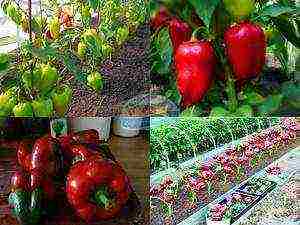Content
- 1 Characteristics of black walnut
- 2 Growing black walnut
- 3 Black walnut pruning
- 4 The benefits of black walnut fruits
- 5 Why are black walnut fruits harmful?
- 6 Black walnut wood
- 7 Description
- 8 Growing
- 9 Characteristics of black walnut
- 10 Fruit of the tree
- 11 American walnut at their summer cottage
- 12 The subtleties of planting and caring for a nut
- 13 Basic fertilization rules
- 14 Diseases and parasites
.
Black walnut is the closest relative of the well-known walnut. Black walnut is native to North America, but there are many other places where black walnut grows. It has become widespread due to its use in medicine, cooking and everyday life. The tree got its name due to the specific color of fruits, wood and roots.
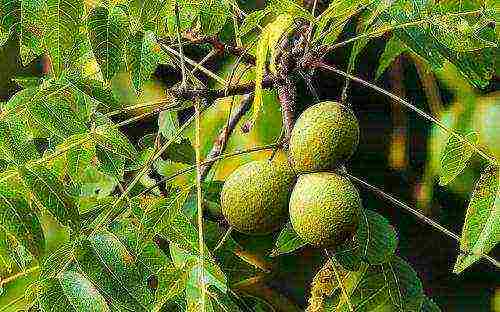
Black walnut is a close relative of walnut
Characteristics of black walnut
The plant has a number of features that make it difficult to confuse it with other nuts.
The tree looks like this:
- the crown is quite wide, with low spreading branches;
- the bark has a chocolate-black hue with deep cracks along its entire surface;
- wood of dark brown color, has a strong texture, easily amenable to mechanical processing;
- stem rhizome, extending over great distances;
- leaves are pinnate, oval, excised with small notches along the outer edge;
- throws out long, light green catkins when blooming in the middle;
- round shape of the fruit with a pointed end, during ripening the peel is light green, later darkens;
- the shell of the fruit has a special dark color.
Black walnut can be found throughout Europe except the Scandinavian countries, because the climate there is too harsh for this tree. It also grows in deciduous forests of central Russia, where it was introduced at the end of the 18th century.

Young fruits of black walnut have a light green skin.
Growing black walnut
If you decide to grow black walnut on your site, you need to take into account some of the features of this tree. Leaves are capable of producing phytoncides - biologically active substances with bactericidal properties. They not only fight bacteria, but they also improve respiratory function and heart rate, as well as help to cope with headaches or migraines. But in addition to pathogenic bacteria, with a high concentration of phytoncides in the air, those that are vital for the human body can also die. For this reason, it is better to plant young trees at a distance of 15-20 meters from each other.
Seedlings for breeding can be purchased in nurseries or grown independently from a nut. The second option will take longer.
The walnut is soaked for several weeks in room temperature water, constantly changing it so that it does not stagnate. After pecking, the sprout is planted in fertile wet soil.
The plant has some requirements for environmental conditions and care:
- Black walnut does not like sour and slightly acidic soil. Preference is given to neutral and slightly alkaline soil, otherwise the plant will not be able to prepare for winter in time and will die.
- The tree loves moisture very much. In Indiana, black walnuts are flooded for one month or more during floods. The roots at this time are completely under water, but the plant does not receive any damage from this.
- The temperature regime largely depends on the age of the nut and its condition. Despite the fact that it comes from a warm region, an adult, healthy tree is able to survive normally winter with frosts down to -40 ° C, and young or injured trees do not.
It is not recommended to plant birch, apple, pear and plum, tomatoes, potatoes and other nightshades in close proximity to a tree. Plants planted close to a black nut will die so quickly that the gardener will not have time to understand what happened to them. By producing the juglone toxin, black walnut very quickly inhibits the plants closest to it.
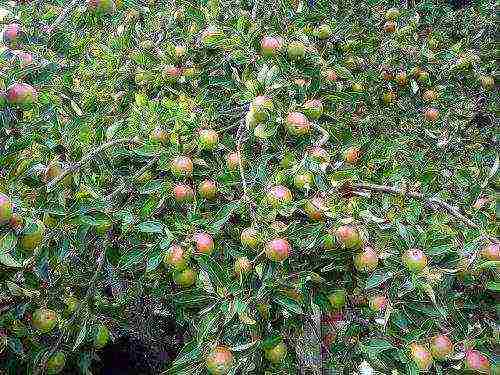
The apple tree will not grow near the nut
Black walnut pruning
Planting and grooming also includes pruning the tree. A properly formed crown increases the yield of the tree and encourages the growth of lateral branches. A special feature of this tree is its typical growth pattern for forest plants. The trunk lengthens over time and clears of the lower branches, forming a green mass at the top.
It is best to prune in the spring when the threat of severe night frosts is low. Dry branches are removed with a pruner or saw. Branches directed towards the middle of the crown should also be pruned. The renewed tree gives bountiful harvests.
To make the tree squat, the apical pruning method is used, removing the top growth point from young trees at the age of three years.
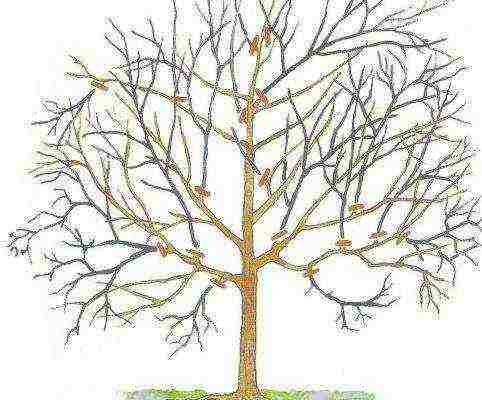
When pruning, branches are removed that are directed towards the middle of the trunk.
The benefits of black walnut fruits
Black walnut fruit is used as a dietary supplement. They are a source of fatty acids, trace elements and vitamins of groups B, A, PP, E and C. 10 nuts contain a daily dose of iodine, which improves the functioning of the thyroid gland and helps to strengthen the immune system during colds and respiratory diseases. Also, black nuts are a source of carotene and tannin.
They have the following qualities:
- improves skin tone, helps to smooth mimic wrinkles;
- dilates blood vessels, lowering blood pressure;
- relieves muscle spasms, especially fights pain in women during menstruation;
- destroys worms, helps to cope with intoxication with the waste products of parasites;
- strengthens the immune system;
- reduces the risk of malignant tumors;
- cleans blood and lymph;
- reduces irritability;
- eliminates free radicals;
- helps fight infectious diseases;
- cleanses the skin of the face from acne;
- stimulates the brain.
The properties of black walnut make it an indispensable product in the diet of any person, especially those suffering from diabetes mellitus and impaired glucose absorption. Thanks to the substances contained in the kernels of the nut, the work of the pancreas, liver and kidneys improves.

Black nuts have a whole range of medicinal properties
An adult is recommended to consume 8-10 nuts a day to get enough natural iodine, vitamins and minerals. Children should be given no more than five.
The kernels can be eaten fresh and lightly toasted. In the second case, the nucleoli acquire a refined taste, but lose most of the nutrients. Also, the fruits of black walnut are used to prepare desserts and as a seasoning for first and second courses.
In medicine, in addition to the kernels of this nut, the juice of the plant's pericarp is used. The green pulp is pressed to obtain a dark brown iodine-rich liquid.
With its help, you can stop bleeding and significantly speed up wound healing. Also, a tincture is made from the pericarp, which helps to cure thrush without pills and suppositories.
Why are black walnut fruits harmful?
Despite the huge list of positive aspects of eating black walnut fruits, there are also disadvantages. Due to their high fat content, kernels are high in calories. For this reason, people who are overweight are advised to consume nuts with great care. Allergy sufferers should not abuse this delicacy. Nuts are strong allergens and can lead not only to itching and rashes on the skin, but also to Quincke's edema.
Pregnant and lactating women, children under 5 years old should be careful to consume the fruits of black walnut. Do not eat roasted nuts for people suffering from gastritis and cholecystitis.
When buying black walnut fruits, make sure they are fresh and free of mold on the kernels. Otherwise, you can get severe poisoning.
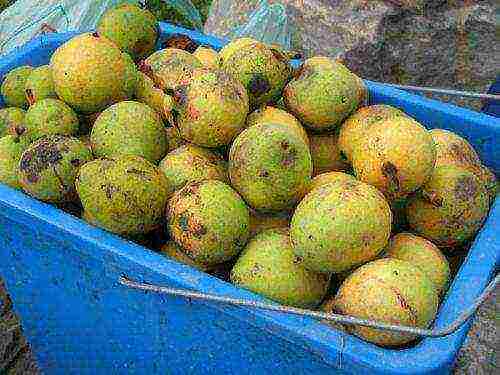
Black nuts should be carefully inspected for mold.
Black walnut wood
The cultivation of black walnut is practiced not only for harvesting, but also for harvesting wood. Due to its unusual color (dark gold), wood is used in furniture production. Furniture made of such wood is not only beautiful, but also resistant to the influence of external factors, has antiseptic properties. Thanks to the content of glycosides, essential oils and organic acids in plant tissues, the furniture is protected from fungi and the reproduction of pathogens.
The only drawback of the material is its low strength. When sawing, the wood bends easily. This can be considered a plus, because the elasticity of wood is required to assemble complex decorative structures.
If black walnut planks have been properly dried and stored in proper conditions, then furniture made of such material will last a long time. In addition to furniture made of black walnut wood, they also make:
- butts for weapons;
- musical instruments;
- floor coverings;
- decor items.
From a medical point of view, black walnut is also very useful, and therefore, is actively used in pharmacology to create extracts, tinctures and powders.
Subscribe Be aware of new products on our site
The black walnut tree got its name not at all because the fruit or trunk is black. A powerful black root system played a role here. The second name of the tree is American walnut, because it can grow in its natural form only in the forests of North America.
Description
There are several features that distinguish the black walnut tree from others:
- the tree reaches a height of 50 m;
- the trunk is chocolate brown;
- the crown is lowered down, it is characterized by a wide vaulted shape;
- black roots, with deep cracks;
- rod-type root system;
- begin to bloom from the age of 7-10 years, the flowering months are April and May;
- fruits are round, ovoid, with a pointed tip, their diameter is 3-5 cm.
Growing
The people of North America know for sure where the black walnut grows. This country is his homeland. From Texas and Florida to Massachusetts. The plant was brought to Russian cities in the 18th century. Today, the tree is quite common in all European countries, except for the Scandinavian region. After all, there are too cool climatic conditions for him.
The walnut tree tends to grow in areas such as:
- deciduous forests;
- mountains with fertile and moist soil type;
- on the banks of water bodies;
- along the alleys, etc.
Germination of American Black Walnut should be started in early April. This is done as follows:
- Place the nut in a glass container and fill with water, which should be at room temperature.
- Change the water for three days every day at the same time - in the morning or in the evening.
- Transfer the nut to wet sand for 15 days. In this case, he should be placed on the edge sideways. Place the nut in a flower pot or a cut bottle with holes in the bottom to drain the excess liquid. It should be buried at a depth of about 10 cm.
The container with the planted nuts should be at room temperature. Under such conditions, almost all fruits germinate and roots begin to grow, and sometimes shoots come out. The first days of May, in good weather, is a good time for planting nuts down the roots. Plants are planted in specially made holes, the depth of which is 8-12 cm. It is advisable to maintain a distance between the nut and the surrounding trees. It should be about 10 m.From buildings to the walnut, the distance should not exceed 3 m.
Attention! It is recommended to fertilize the planting site in advance - in the fall. If this has not been done, the soil should not be fertilized after planting the nut.
The first shoots usually appear after 2.5 -3 weeks. In autumn, the nut already reaches 10-15 cm. After a year, the trunk with branches gradually grows fat. In August, it is not recommended to water the seedlings too much. Because in this case it may be difficult for him to endure winter time. The seedling is dug out gently with the ground, without damaging the rhizome. At the onset of spring, a plant that has overwintered is planted again in the right place.
It implies the cultivation of black walnuts from seeds and such an important procedure as crown formation. You need to start in 3-4 years. The best option for forming a crown is to leave 3 side branches and a central conductor. So it turns out to form a tree trunk up to 2 m in height.
The nut begins to bear fruit at the age of 5-6 years, subject to a properly formed crown and proper care. Wood loves moisture and light. The best soil for it is moderately moist calcareous loams with a low groundwater level. This creates a powerful root system that penetrates deep into the soil. Black walnut blooms in spring from April to May. The fruits ripen in autumn.
Black walnut (lat.Juglans nigra)
- a representative of the Walnut genus of the Walnut family. In nature, the species is found mainly in North America. Typical habitats are mixed forests.
Characteristics of culture
Black walnut is a deciduous tree up to 40 m high with a trunk covered with black, deeply fissured bark. Leaves are green, compound, pinnate, alternate, consisting of 11-23 leaflets. The leaves are oblong-ovate or elliptical, with uneven sharp-toothed edges and a rounded base, have a sharp balsamic odor. Flowers are dioecious, wind-pollinated. Female flowers are collected in ears or brushes, male - in complex inflorescences-earrings, the length of which varies from 6 to 12 cm. Black walnut blooms in the middle lane in mid-May.
The fruit is pear-shaped or spherical, light green, pubescent with glandular hairs, reaches 3.5-5 cm in diameter. The peel of the fruit is thick, fleshy, cracks when ripe. The nut is ovoid or round, pointed towards the top, dark brown or black, and has a thick shell. The kernel is medium-sized, oily, edible. The culture enters fruiting in 6-9 years after planting. The fruits ripen in late September - mid-October. Up to 5 fruits are formed on one axis.
Growing conditions
The cultivation of black walnut in the conditions of central Russia is problematic, since the plants are quite demanding on soil conditions and location. Black walnut is a light-loving culture, however, in terms of shade tolerance, it is not inferior to gray walnuts and walnuts. The plant is thermophilic, the optimum temperature for growth and development is 22-24C. Black walnut does not differ in frost resistance, although botanists have found that some representatives are able to withstand short-term frosts up to -38C. The culture has a negative attitude towards spring frosts, especially for young, still immature plants.
Black walnut is relatively drought-resistant (in comparison with Manchurian walnut and walnut). Calmly tolerates short-term flooding. Soils are preferable neutral or slightly alkaline, fertile, loose. The presence of phosphorus and potash fertilizers in the soil is encouraged. Black walnut does not tolerate acidic, saline and swampy soils, as well as soils containing a large amount of nitrogen. In areas with an excess of nitrogen, plants slow down their growth, do not have time to ripen by the cold and, as a result, are damaged by frost. Black walnut needs protection from cold winds. In the lowlands, growing a crop is highly undesirable.
Planting and leaving
A planting hole for black walnut is prepared 14-20 days before the intended planting. The depth and width of the pit depend on the size of the root system of the seedling. The roots of a young plant should be placed in the hole freely, this will have a positive effect on further growth and general condition. Phosphorus and potash fertilizers, wood ash and humus are mandatory introduced into the pit. Fertilizers should not come into contact with the root system, therefore, before applying, they must be thoroughly mixed with the top layer of soil. The seedling is lowered into a pit, covered with soil by 1/2 part, moistened abundantly and after 5-10 minutes the remaining soil is added, after which it is compacted and mulched with organic material.
At a young age, black walnut needs regular watering. Adult plants need abundant moisture during prolonged drought, during the period of active growth and flowering. In the second half of summer, watering is reduced, this is necessary for the timely completion of the growth of the nut, the ripening of the wood and its preparation for stable cold weather. In dry summers, moisture is also necessary at the time of fruit formation. Loosening of the trunk circle is encouraged. Sanitary trims are required, shaping - optional. Sanitary pruning is the removal of dry, diseased and frostbitten branches. Thickening branches are also cut out.
Application
Black walnut kernels are used in cooking and medicine. Kernels are especially widely used in the confectionery industry. The kernels are known to be rich in ascorbic acid, tannins, organic acids, carotenes, vitamins and flavonoids. Nuts are often included in dietary supplements and medicinal tinctures. Black walnut wood is used in the manufacture of furniture, flooring, wall panels, propellers for helicopters and aircraft, rifle butts and musical instruments.
.
Black walnut is a culture little known in our latitudes. It got its name from the black color of the tree bark. In appearance and taste, it practically does not differ from the well-known walnut.
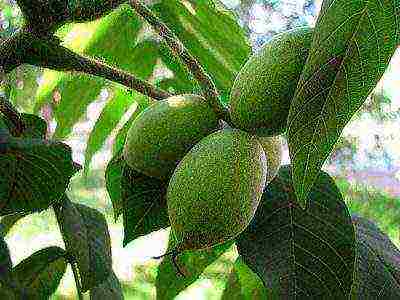
In our latitudes, black walnut is a little-known crop.
In some sources, the plant is called the American walnut. This is due to the fact that it occurs naturally only in North America. It is thanks to the inhabitants of this country that we learned what a black walnut is.
Characteristics of black walnut
The black walnut tree is common in Europe and the Scandinavian countries. It is famous not only for its fruits, but also for its strong wood, which belongs to the valuable species of mahogany. It is a sturdy and large tree.
On the North American continent, the black walnut can grow up to 50 meters in height, and the trunk diameter is often more than 2 meters. In our latitudes, it does not grow to such a size, since black walnut is a thermophilic tree, although it tolerates long-term frosts well.
Black walnut is planted in summer cottages due to its beneficial properties. It cleans the air from dust well, and its crown emits a huge amount of useful substances. If there is a choice between planting a walnut or a black nut, then the latter will be the best choice, but growing a black nut will take a long time, and the first fruits will appear only after 7-10 years.
Fruit of the tree
Once you have learned how and where the black walnut grows, several unique properties of its fruit can be noted. Despite the fact that walnuts and black nuts are the closest relatives, their fruits are different.
Their first difference is the size of the fruits. Black walnuts are larger than walnuts, and the skin looks much darker. Due to its hardness, this nut is practically not used in cooking, but the fruits of the black walnut are used in medicine and the cosmetic industry.
American walnut at their summer cottage
Rules and recommendations that you need to familiarize yourself with if you decide to plant a black nut:
- Attention should be paid to the composition of the soil.Black walnut will not grow in acidic soil, it needs a slightly alkaline or neutral soil. Only in this environment will the plant independently be able to regulate its growth and go into hibernation in time.
- The soil must be fertilized. To do this, wood ash or a complex of special fertilizers are added to the planting pit.
- The tree can grow for 50 years, it will take a lot of space. It is undesirable to plant other trees and bushes near it. During growth, the nut will shade them from the sun. This is also due to the fact that an adult tree secretes phytoncides. They are the strongest natural antibiotic that kills not only viruses and bacteria, but also useful substances.
- A young tree does not tolerate the currents of northern air, so it must be protected from strong gusts of wind.
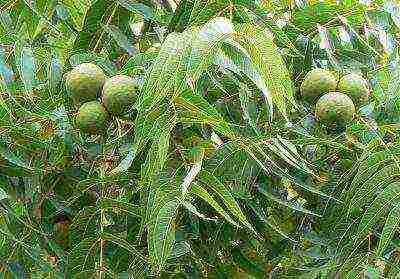
When planting and growing black walnuts, a number of recommendations must be taken into account.
The subtleties of planting and caring for a nut
What is planting and caring for a plant? Breeders or experienced summer residents are engaged in nut cultivation. There are three ways to breed black walnuts:
- seeds;
- with clothespins;
- cuttings.
The first method is especially popular. A tree grown from seeds adapts better to environmental conditions.
The tree is planted in mid-spring.
For this, a planting hole is dug with the calculation of free space for root growth. The bottom is fertilized with humus, wood ash and potash-phosphorus fertilizers. In the case of planting seedlings, two-thirds of them are covered with soil and watered, after which the rest of the soil is filled up.
It is important to regularly loosen the soil after planting and during growth, this promotes rapid growth. But this is done only in the spring and summer months. Loosening must be stopped in August. This will allow to suspend the growth of walnut pagon, which serves as a symbol of the coming cold weather.
Black walnut, especially the Indian Gold variety, needs a lot of moisture, it needs abundant and timely watering. Particular attention should be paid to the irrigation system during the growth and flowering period. An adult tree no longer needs systematic watering. The exception is the drought period.
Unlike many other plants, the American walnut does not need to form a crown, its shape is genetically laid down, but if necessary, it is worth cutting off dried or damaged branches. It is recommended to carry out this procedure after bud break, otherwise the awakening of new buds and the growth of shoots in an unfavorable period may be provoked.
Suitable temperatures for growing black walnuts range from +7 to +10 ° C. This is especially important in the first three years, when they need protection from temperature extremes and strong gusts of wind. Adult nuts tolerate short-term winter frosts well.
During growth, the tree needs to be in direct sunlight, so it is not recommended to plant it in places where it is dark (near houses and tall plants).
Basic fertilization rules
The first stage of soil fertilization begins long before the plant is planted. Soil preparation begins in the fall, six months before the seedling or seed is in the ground.
Fertilization rules before planting:
- compost or humus is introduced into the ground at the rate of 3 kg per square meter;
- 10–12 days before planting, the already dug hole is filled with a small amount of superphosphate (100–150 g) and several buckets of humus;
- fertilizer is evenly distributed around the perimeter of the pit, after which the plant is planted.
To increase the chances of survival, the roots of the plant can be treated with a special solution.
Diseases and parasites
Basically, this strong and powerful plant is not susceptible to attack by parasites and disease-causing infections.
Bacteriosis is a common problem and appears as black spots on the leaves. This leads to deformation of leaves and fruits.The disease is born in the root system and the best prevention against it is timely harvesting of fallen leaves.
Rainy weather creates conditions for the appearance of bacteriosis. Of the chemical agents, Bordeaux liquid is used for treatment, but spraying will be effective only if the infection has not reached the flowers.
Brown spot can be another ailment. Many fruit plants (plums, cherries, tomatoes, etc.) suffer from it. Its main difference is the appearance of brown spots on the leaves of the plant. In advanced cases, it covers the leaf completely, and it falls off. This disease also spreads to unripe fruits. During the period of damage, the plant should not be actively watered. In the fight against this ailment, preparations of the fungicide group will help. These can be purchased from a specialist store.
The cultivation of black walnuts requires special attention and favorable conditions. In order for you to get the first harvest in a few years, you need to try and take care of the tree.
Subscribe Be aware of new products on our site

